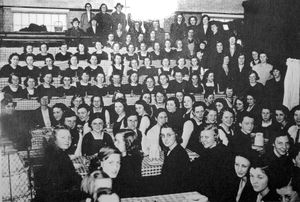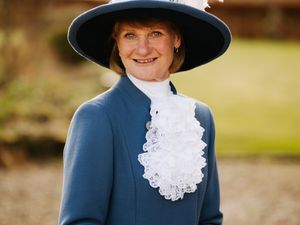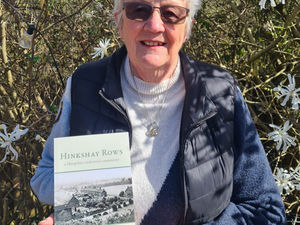A moving experience for schools in danger
The war was only a few hours old when a pre-arranged plan by staff and pupils of Birkenhead Institute swung into action.

It was one of a number of schools from areas threatened by bombing to evacuate lock, stock, and barrel, to Shropshire.
On September 3, boys and masters boarded a special train for Oswestry, where they were to share the buildings of Oswestry High School.
As it happened, when they arrived the buildings were not immediately available, so the first fortnight was spent "practically al fresco in Cae Glas and the surrounding countryside," according to an Institute history.
"When we were able to use the High School, the afternoon sessions were generally held there. But other buildings had to be requisitioned to maintain a full timetable, particularly the Memorial Hall adjoining the celebrated cattle market.
"Lessons took on a new dignity when they were held in the Oddfellows' Hall, and everyone sat in a massive carved armchair."
Yet the history declares the evacuation to Oswestry was a failure, for two reasons.
"Firstly, only half the school took part in it, and, secondly, the absence of air raids in 1939 gradually made it appear unreal and pointless."
The upshot was that the Institute was reopened at Birkenhead on November 5 for those boys who had stayed. Then so many boys returned from Oswestry for the Christmas holiday that it became clear that the Institute would have to be fully reopened at Birkenhead.
"Thus, from January 1940, the main body of pupils reassembled at the Institute, and the Oswestry 'branch' gradually died of attrition, finally disappearing in April."
Lancing College on the Sussex coast fetched up at Moor Park, near Ludlow, but there were boys at a number of satellite houses who would go to Moor Park daily for tuition.
These included Ashford Court, which was in the hands of the Fraser family, who found themselves having to move into the chauffeur's house. Other satellite houses were at Caynham Court and the Lodge at Overton, and also, by at least one account, Downton Castle.
One of the famous pupils from the college's time in Shropshire was novelist Tom Sharpe.
There remains a Teme House, named after the river which flows in part through south Shropshire, at Lancing College to this day.
Croft Castle in Herefordshire became a school from the autumn of 1939 to the spring of 1946, while during the war the girls of Priory Girls Grammar School in Longden Road, Shrewsbury, had to share the use of the school with evacuated pupils and staff of Queen Mary’s High School, Liverpool.
The Shropshire girls had the mornings, and the Liverpool girls had the afternoons.
A large vegetable patch was dug in the school grounds to help the war effort, and everybody knitted for the forces.
Cheltenham Ladies' College, one of Britain's most prestigious girls' schools, was evacuated to Lilleshall Hall, and Holly Lodge School for Girls from Smethwick was evacuated to Wellington from 1939 to Easter 1940. The 221 evacuees were taught at Wellington Girls High School in King Street, which was so crowded that it worked a shift system.
From 1939 to 1940 Attingham Park was briefly turned into a schoolhouse when an entire Birmingham school, Edgbaston Girls' High was evacuated to it.
Aldenham Park, near Bridgnorth, became the wartime home for more than 50 girls from a London convent school.
It was the home of the Acton family, who were prominent Catholics, and so it was fitting that the arrivals were the sisters and pupils of the Convent of the Religious of the Assumption.
The school was based in Kensington Square, but in 1939 the building was needed by the ARP (Air Raid Precautions) so the sisters had to find a new home for the school and nuns.
The vanguard from the school, of 10 choir sisters and five lay sisters, arrived on September 1, 1939, with the children soon to follow.
Julie Summers, author of the book Our Uninvited Guests, The Secret Lives of Britain’s Country Houses 1939-45, said: “Within days of arriving at Aldenham the nuns became convinced the house was haunted. There were several ghostly happenings which frightened them and the girls alike.”
Despite the valuable addition of fruit and vegetables from the garden, the food was described as revolting.
“After the food, what the girls remembered most was the cold. The main problem with the house was that it had not been designed for so many inhabitants.”
The school uniform was a navy blue dress with a white removable collar, and conditions in their new home were tough, with a leaking roof and no heating. Washing was done on site and according to one pupil they were only allowed to change their underwear once a week and washing was equally infrequent, with the upshot that two girls sent their washing home and it came back in biscuit tins, sometimes with a cake.
Julie says the school complement was 54 teenage girls, 15 nuns and a nursing mother.
She says for six years the school thrived at Aldenham Park, and on the whole the girls loved life there. The school moved out after the end of the war in Europe. It did not go back to Kensington Square, as the buildings had been designated to be a new teacher training college, but went instead to another house, Exton Hall in Rutland.
An Open University thesis published online which researched English boys' preparatory boarding schools up to the early war period reveals there was a small tidal wave of these institutions alone into Shropshire during the war years.
Those listed in Jonathan Austin's research include Heatherdown, at Ascot, which was evacuated to Downton Hall, near Ludlow, in 1941. Others include: Mistley Place, Manningtree, Essex, evacuated in 1941 to Bedstone Court, near Bucknell; Hawtrey's at Westgate, Kent, to Oswestry in 1940.
Northaw, at Pluckley, Kent, came to Loton Park, Alberbury, in about 1941 – Northaw had joined with a second prep school called Arnold House from St John's Wood, London, which also went to Loton.
Sir Michael Leighton, who had moved out of Loton in 1939 to stay with his grandmother a few miles away at Whiston Priory at Cardeston, became one of the pupils at the evacuated Northaw school.
Orwell Park (originally called Aldeburgh Lodge) in Suffolk, came to Bedstone Court in 1941.
Ripley Court, at Ripley, Surrey, to Betton Strange in 1941; Glengorse, at Battle, Sussex, to Longnor Hall, Shrewsbury, in 1941; Langley Place, at St Leonards, Sussex, first to Staffordshire in 1941, and then to Benthall Hall, Benthall, in 1942; Hurst Court, Ore, Sussex, to Wrekin College, in 1940; West House, Birmingham, to Millichope Park near Craven Arms in 1941.
Packwood Haugh, at Hockley Heath, moved (as opposed to evacuated) to Ruyton-XI-Towns in 1941; Woodroughs, Moseley, evacuated to Stanway Manor, Rushbury, in 1941; and Lickey Hills, Rednal, Worcestershire, to Brampton Bryan Hall in 1940.





